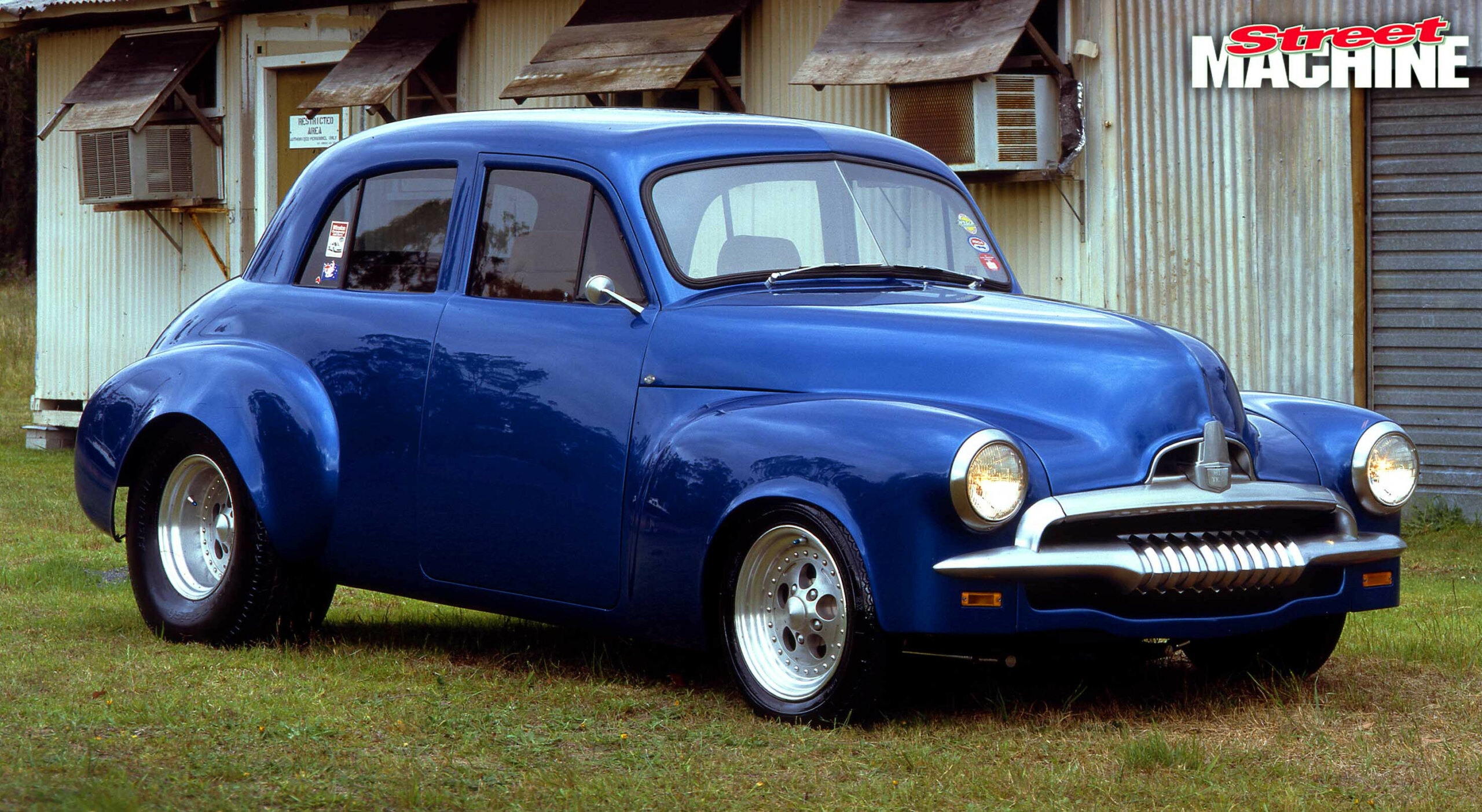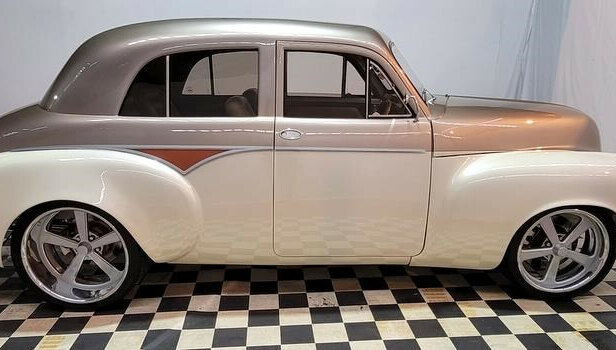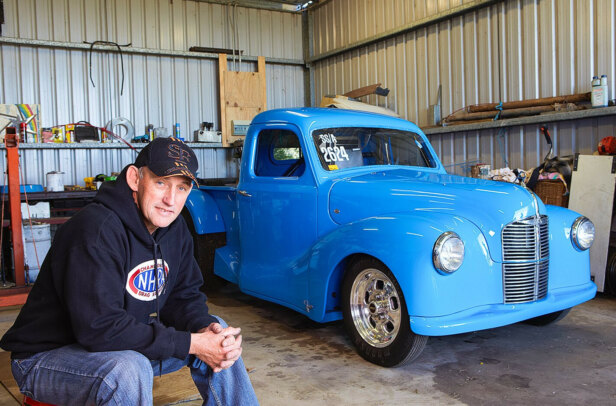In 1986, Rex Webster’s astonishing ’55 FJ Holden blew our street machining minds. Here’s a look back at the original story detailing the creation and incredible attention to detail of this revolutionary masterpiece, as it was first published in the December 1986 issue of Street Machine.
IN ALL likelihood you’re gazing at Australia’s best street machine, a car that’ll go down as the benchmark for customisers in the 80s. If this Cosmic Blue knockout drop isn’t a potential candidate to sweep the major awards at next year’s shows, then we can’t tell a Triumph Mayflower from a T-Bird. So spectacular is the concept and workmanship in Rex Webster’s ’55 FJ Holden that it’ll probably redefine current street machine judging criteria in Australia. It also adds a new meaning to the word ‘enthusiast’ while also suggesting that craziness is closely associated with dedication.
Get this…
• Rex and brother Tony have spent five years – virtually every day and every night – working on the FJ
• Rex sleeps with the car and a dog
• He closed his business to devote all available time to the FJ
• He financed the resto project by selling off everything he owned, including the roof over his head
• Five months’ constant work went into just panelbeating the floor
• Every cast part on the car has been ground down, smoothed off and painted to perfection
• All original bolts – thousands of ’em – have been discarded in favour of hex-key heads
• There’s not one self-tapper left
• Three months were spent stripping down three Weber carbies, then eliminating every cast mark
• A sensor-touch panel controls all major functions – ignition, lights, doors, electric windows and so on
• Dozens of bits have been handmade from solid alloy billets
Thousands of man-hours and at least $30,000 have gone into the incredible project. It’s not finished yet, though no one except the never-satisfied Websters would know. In the flesh the car is a dazzling piece of art, and the story behind its creation is also pretty incredible.
Interview: Legendary street machine builder Rex Webster
High Tech as it appeared at 2008 MotorEx in Sydney, the first rebuild by Paul Beck
Rex Webster is a quiet, retiring, totally committed man with a ZZ Top beard and a dream of producing the most spectacular street machines of all time. That commitment includes shutting down the Webster Brothers panel shop 14 months ago, so he and Tony could devote all their time to the car they call High Tech.
Rex, 28, now generates a small income from mowing lawns, a job that gives him the flexibility and the funds to proceed with making his dream a reality. Every day and evening he works on the FJ.
He sleeps on the job, in the workshop on an industrial estate. A guard dog is his company. For this lad it’s concrete, not carpeted floors. He has no other living quarters, he is perpetually flat broke: outside the necessities, every dollar he earns goes straight into High Tech. He cashed up his caravan that once served as his home. Naturally, Rex has no social life. Absolutely none. He has paid a heavy penalty – no birds.
Lonely, eccentric or merely obsessive? The fanatical Websters believe every part of the motor car – even those bits you can’t see – should be faultless. Rex’s plans include a stint in the USA (at the end of 1987) where he feels he can learn more about the art of crafting street machines.
High Tech will never be finished, because the Websters will never be completely satisfied. As sensational as the reborn FJ is now, Rex Webster readily admits it can be improved. “I think it should be pulled apart and rebuilt,” he declares. Yep, he’s a perfectionist.
The story really began 12 years ago when the brothers bought the FJ for drag racing purposes. The car pounded down a quarter-mile strip for five or six years, powered by the same heavily worked 186 that’s still in it today. The brothers later bought another drag strip special, a Capri with a big-block, but Rex elected to hang onto the FJ.
The FJ project began quietly. Work proceeded between pay jobs for clients. Quickly though, it became Rex’s magnificent obsession. The force within overwhelmed the reserved but single-minded man from the Newcastle suburb of Redhead. Everything else went on hold while he concentrated on perfecting High Tech. As the project became more intense, and closer to realisation, the Webster boys increased their efforts to keep their jewel away from prying eyes.
It’s a subtle car. From 50 metres off there’s no inkling of what lurks in every nook and cranny. A glance doesn’t do it justice – you need an hour to soak up all the Webster influences.
Obviously the paint job is special and the grille looks kinda different. Oh, it’s alloy-look brushed satin chrome. And the headlight rims are done the same way. High Tech has been carefully converted to two-door configuration. Check it out closely and there’s not the slightest hint of the custom joins.
The Websters have gone for the super-smooth look. The roof guttering has been removed and the lights recessed. Beneath flared guards are 15-inch Center Lines – ten inches wide with big 33-inch-tall BFG Comp T/As on the rear, and slender Michelins on narrow four-inch rims at the front.
The Cosmic Blue paintwork is just perfect. That’s all. Ten coats followed by five of clear, but on a surface that received countless hours of preparation. The inner guards are no less immaculate. The floor is phenomenal – the five months spent eliminating three decades of bumps and wear and tear was well spent, restoring it to a condition beyond original.
The Webster brothers’ special emphasis is clearly on building a show car rather than a performance beast. They haven’t opted to drop in a 350 or something similarly tough and punchy.
Not that the 186 is mild. It has a steel crank, solid lifters, Crane roller rockers and a few other hot items that the Websters have all but forgotten about in the 10 years since the engine was first given the treatment. Local performance people Wilkie did the head job and there’s also a Warner manifold and six shiny trumpets belonging to triple 45mm Webers.
But the power spec isn’t the highlight of the engine bay. The talking point is, logically, the custom techniques and workmanship. The engine block is now as smooth as a baby’s backside. There’s not a cast mark to be seen. It’s been painted in Cyan Blue to a standard the equal of the car’s exterior. And it’s been pinstriped.
Likewise every cast mark has been patiently filed and rubbed from the Webers, a job that took Rex three months. Oh, what fun. This bloke’s probably such a masochist he enjoys having teeth pulled.
Really though, you’ve got to admire his application. Let it be known too that the manifold, gearbox, bell housing, diff, disc brakes and calipers have all been similarly treated. And the steering box, pitman arms, tie rods, king pins, stub axles. They’ve been ground down and painted Cosmic Blue.
Under-bonnet chromium isn’t way over the top. Earl’s braided lines, polished alloy and occasional flashes of chrome contrast easily with the blue engine bay. The underbody is immaculate. Magnificent. Unbelievable. Bloody t’riffic.
Earlier we mentioned every nut and bolt and self-tapping screw had been replaced with a hex-key bolt. What we didn’t say was that the Websters filed off the serrated edge on every one of ’em. There are also hand-tailored press-on aluminium caps for those bolts.
HANDMADE
There’s quite a list of handmade solid alloy bits. It’s bloody handy to have two mates who are machinists. So High Tech has a beautifully crafted one-off radiator cap and breather cap and master cylinder cap.
Also tailored is the wiper body, steering column shroud, various clamps, door catches, blinker arm and knob, water pump pulley, wheel nuts, valve caps (no kidding) and even the dipstick.
The special knob on top of the Hurst shifter is stainless. The all-alloy external mirror began life as a solid billet. There’s other stuff too that slipped Rex’s mind.
There isn’t a weak point on Rex Webster’s FJ High Tech. It’s a masterpiece of machining. The mirror started life as a solid billet, the interior was computerised and the engine bay? Unbelievable!
Power goes via a Holden one-tonner clutch through a Saginaw 4-speed then onto a 10-bolt Chev rear end running a quarter-mile special, a 5.1 diff and shortened Chev axles.
Brakes are discs all round – HQs up front and Commodore rears. Shockers are Monroe Wylie, while a K-Mac stabiliser keeps the body roll down. Springs have been lowered. But this doesn’t signal an end to suspension development. The Websters are currently fabricating their own complete front suspension.
The computer age has not passed by this 30-year-old Holden. On a special dash face, cast in aluminium and three inches deeper than the original, there’s High Tech’s high-tech gear.
Extending along the bottom of the dash is the Telstar mobile entertainment unit that’s been imported from the US. It comes with radio, tape deck, graphic equaliser, television, video, CB and sensor touch panel.
The touch-sensitive computerised panel controls ignition, start, lighting, heaters, wipers, washers, doors, boot, horn and windows. The Websters also machined their own openings in the dash to take the various gauges. The overall effect is knockout.
The interior trim is light brown velour. But again, it’s not exactly ordinary. Remember this is now a two-door car and to give passengers that impression, trimmer Bob Grimshaw extended the headlining down to camouflage what were once rear door openings.
The rear seating is stock; fronts are Mazda buckets. The list of mods has no end because there is no end. By ’87 it should have an all-new Webster-designed front end, plus a host of handcrafted aluminium components.
We’ve never seen anything like it – and we doubt we ever will again, for this is world-beating stuff. Take a bow, fellas, you’ve just upped the ante for the sport of street machining.
Rex Webster
FJ Holden sedan
Featured: December 1986
Cool info: Webster’s High Tech FJ Holden influenced a generation of street machiners. It is possibly the most perfect Aussie street machine ever created
Paint: Cyan Blue
Engine: Holden six-cylinder 186ci
Gearbox: Saginaw four-speed
Diff: Chev 10-bolt
Wheels: 15×10 & 15×4-inch Center Lines
Interior: Mazda buckets, with crushed velour trim




Comments